
Developed for the Waring Library Society’s annual meeting, this web exhibit supports this year’s keynote lecture given by Dr. Irving Kushner, the director of the Division of Rheumatology at MetroHealth Medical Center and professor at Case Western Reserve University in Cleveland, Ohio.
View exhibit as list
When viewing the exhibit, run your cursor over artifact to view captions or click on an image for an enlarged view.
- List of exhibit content
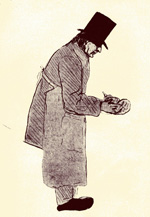 J.-M. Charcot, 1825-1893: His Life - His Work
J.-M. Charcot, 1825-1893: His Life - His Work
The pathologist and former student of Charcot, Édouard Brissaud, sketched this likeness in 1875. (Image reproduced from J.-M. Charcot, 1825-1893: His Life – His Work, by Georges Guillain, edited and translated by Pearce Bailey, 1959.)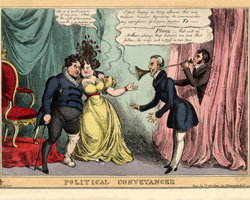 Image is from the Waring Historical Library’s Caricature Collection.
Image is from the Waring Historical Library’s Caricature Collection.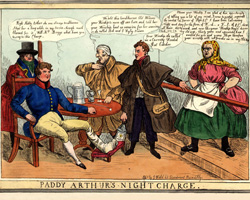 Image is from the Waring Historical Library’s Caricature Collection.
Image is from the Waring Historical Library’s Caricature Collection.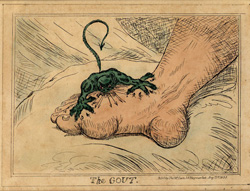 Image is from the Waring Historical Library’s Caricature Collection.
Image is from the Waring Historical Library’s Caricature Collection.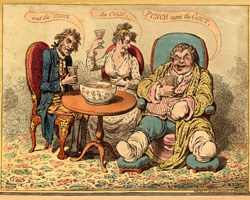 Image is from the Waring Historical Library’s Caricature Collection.
Image is from the Waring Historical Library’s Caricature Collection.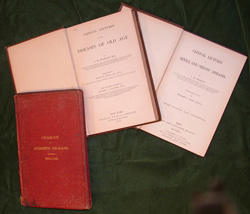 A selection of texts authored by Charcot housed in the Waring Historical Library’s collection.
A selection of texts authored by Charcot housed in the Waring Historical Library’s collection.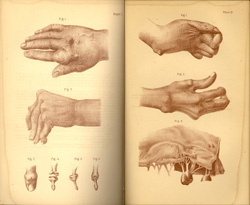 In 1853, Charcot defended his doctoral thesis. In it, he differentiated the symptoms of gout from those of chronic rheumatism. The plate on the left illustrates the outward manifestations of gout. Figure 2 shows the left hand of a woman who died in the Salpêtrière in 1863. The plate on the right illustrates the characteristics of general chronic articular rheumatism. (Images reproduced from Charcot’s Clinical Lectures on the Diseases of Old Age, translated by Leigh H. Hunt, New York, 1881.)
In 1853, Charcot defended his doctoral thesis. In it, he differentiated the symptoms of gout from those of chronic rheumatism. The plate on the left illustrates the outward manifestations of gout. Figure 2 shows the left hand of a woman who died in the Salpêtrière in 1863. The plate on the right illustrates the characteristics of general chronic articular rheumatism. (Images reproduced from Charcot’s Clinical Lectures on the Diseases of Old Age, translated by Leigh H. Hunt, New York, 1881.)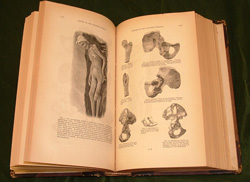 In August 1881, Charcot delivered a lecture on the arthropathic affections of locomotor ataxy at the seventh session of the International Medical Congress in London. In his lecture, Charcot used a preserved skeleton of a former patient. The text of his lecture, along with illustrations, was published in the Transactions of the International Medical Congress, Seventh Session, 1881, Vol. 1, London.
In August 1881, Charcot delivered a lecture on the arthropathic affections of locomotor ataxy at the seventh session of the International Medical Congress in London. In his lecture, Charcot used a preserved skeleton of a former patient. The text of his lecture, along with illustrations, was published in the Transactions of the International Medical Congress, Seventh Session, 1881, Vol. 1, London.
A quote from Charcot’s lecture:
This is the wax model of a woman aged sixty, Berthelot. This patient has been shown for several years at the Salpêtrière as one of the best existing types, exhibiting the character of ataxic affections of the joints. . . . This is the first time that a complete skeleton of the kind has been preserved. It is common to preserve individual joints; but in this case, as the whole skeleton has been preserved, all the joints can be examined, and many lesions have been found, which were not suspected during life.
Jean-Martin Charcot (1825-1893) is known to many in the American medical profession as the father of modern rheumatology. His numerous contributions in the field included his work differentiating rheumatism from gout. Charcot worked out of Paris’ Salpêtrière Hospital, an institution that treated many of the city’s destitute citizens. Later in his career, Charcot developed an interest in studying the malady of hysteria in his female patients. His studies and the theatrical performances with the afflicted women gained a wide audience composed not just of his students and fellow physicians but also of interested citizens who enjoyed the drama of it all and viewed his lectures – delivered in a theater – as a form of entertainment.
The exhibit features artifacts that highlight these two very different aspects of Charcot’s career. Exhibited materials include texts authored by Charcot, visual images, and a series of colorful caricatures depicting individuals afflicted with gout. The exhibit also features the Waring Historical Library’s facsimile photographic plates depicting women of the Salpêtrière – Charcot’s patients and muses – in various stages of “hystero-epilepsy.” Charcot compiled the original photographs in a series of publications entitled Iconographie photographique de la Salpêtrière (Paris, 1877-1880).
- List of exhibit content
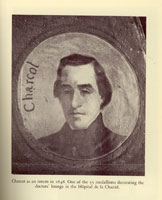 Charcot shown as an intern in 1848. The image is a photograph of one of fifty-five medallions that were displayed in the doctor’s lounge in the Hôpital de la Charité. (Image reproduced from J.-M. Charcot, 1825-1893: His Life – His Work, by Georges Guillain, edited and translated by Pearce Bailey, 1959.)
Charcot shown as an intern in 1848. The image is a photograph of one of fifty-five medallions that were displayed in the doctor’s lounge in the Hôpital de la Charité. (Image reproduced from J.-M. Charcot, 1825-1893: His Life – His Work, by Georges Guillain, edited and translated by Pearce Bailey, 1959.)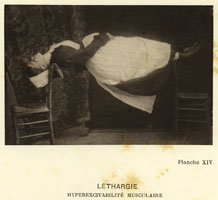
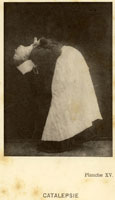 It is believed that Paul Regnard, a young doctor working under Charcot, photographed many of the patients in various stages of hysteria. Charcot compiled the original photographs in a series of publications entitled Iconographie photographique de la Salpêtrière (Paris, 1877-1880). The volumes resembled flipbooks of sequential images of patients in various stages of seizures.
It is believed that Paul Regnard, a young doctor working under Charcot, photographed many of the patients in various stages of hysteria. Charcot compiled the original photographs in a series of publications entitled Iconographie photographique de la Salpêtrière (Paris, 1877-1880). The volumes resembled flipbooks of sequential images of patients in various stages of seizures. 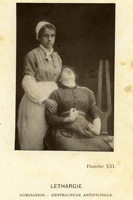
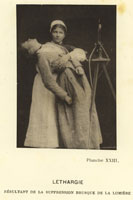 Charcot's experiments in hypnosis and his clinical demonstrations were open to the public and attracted an audience of medical students as well as the general public.
Charcot's experiments in hypnosis and his clinical demonstrations were open to the public and attracted an audience of medical students as well as the general public.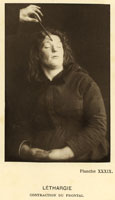
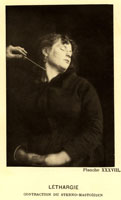
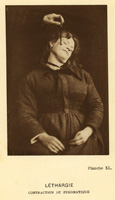 During the later years of his career, Charcot took an interest in the affliction then called hysteria, which he believed to be a hereditary weakness of the neurological system. Hysteria could be triggered by a traumatic event like an accident, but upon inception it became progressive and irreversible. To study the hysterics under his care, he learned the technique of hypnosis. These images depict women under Charcot’s care and in various states of what the doctor believed to be hysteria and/or epileptic seizures.
During the later years of his career, Charcot took an interest in the affliction then called hysteria, which he believed to be a hereditary weakness of the neurological system. Hysteria could be triggered by a traumatic event like an accident, but upon inception it became progressive and irreversible. To study the hysterics under his care, he learned the technique of hypnosis. These images depict women under Charcot’s care and in various states of what the doctor believed to be hysteria and/or epileptic seizures.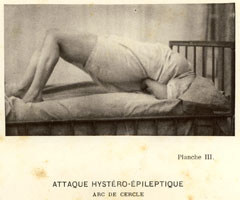
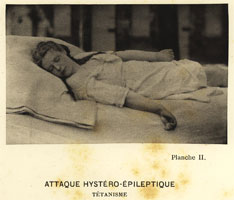
A patient in the throes of an “hystero-epilepsy” attack.
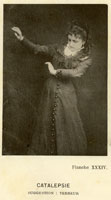
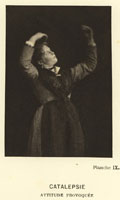 A patient in a more “dream-like” cataleptic state.
A patient in a more “dream-like” cataleptic state.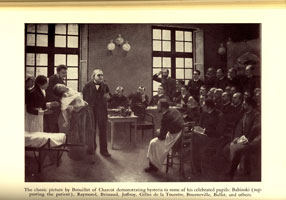 A famous depiction of the doctor in his element, this painting by Pierre Andre Brouillet is entitled “A Clinical Lesson with Doctor Charcot at the Salpêtrière, 1887.” Charcot’s student, Joseph Babinski, is shown supporting the afflicted woman. Babinski later questioned Charcot’s discovery of “hystero-epilepsy” as a disease. (Image reproduced from J.-M. Charcot, 1825-1893: His Life – His Work, by Georges Guillain, edited and translated by Pearce Bailey, 1959.)
A famous depiction of the doctor in his element, this painting by Pierre Andre Brouillet is entitled “A Clinical Lesson with Doctor Charcot at the Salpêtrière, 1887.” Charcot’s student, Joseph Babinski, is shown supporting the afflicted woman. Babinski later questioned Charcot’s discovery of “hystero-epilepsy” as a disease. (Image reproduced from J.-M. Charcot, 1825-1893: His Life – His Work, by Georges Guillain, edited and translated by Pearce Bailey, 1959.)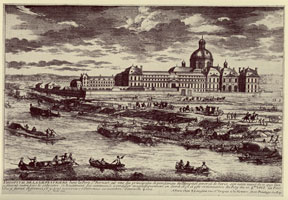 The Salpêtrière Hospital was Charcot’s living laboratory. Of it, circa 1862, he wrote:
The Salpêtrière Hospital was Charcot’s living laboratory. Of it, circa 1862, he wrote:
“This great asylum holds a population of 5,000 persons, among whom are to be counted a large number who have been admitted for life as incurables. . . . We are . . . in possession of a sort of museum of living pathology of which the resources are great.”
The name Salpêtrière dates back to the time when the building was the arsenal and gunpowder store of Louis XIII. During the nineteenth century, the Salpêtrière was an asylum that aimed to cure its patients; at the time it was widely believed the insanity was a temporary ailment. It was largely a hospice for indigent patients. Charcot life's work revolved around the diagnosis and study of these patients.
(Quote from and image reproduced from J.-M. Charcot, 1825-1893: His Life – His Work, by Georges Guillain, edited and translated by Pearce Bailey, 1959.)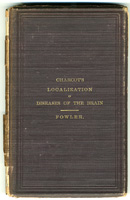 A text authored by Charcot from the collection of the Waring Historical Library.
A text authored by Charcot from the collection of the Waring Historical Library.
About the Exhibit
This web exhibit was designed in 2006 by Sherman Paggi, Web Developer. The web exhibit is based upon a physical exhibit prepared in 2006 by Meg Moughan, University Archivist, and Kay Carter, Associate Curator, Waring Historical Library.
Illustrations and Reproductions. The Waring Historical Library holds the copyrights for some (but not all) of the illustrations and textual images. If you are interested in reproducing items, please contact the University Archivist. As with all copyrighted material, “fair use” guidelines of the applicable copyright laws may apply to educational or other non-commercial uses.
Citation and Attribution. Please cite this electronic exhibition as a whole as: “Dr. Jean-Martin Charcot and the Theater of Medicine,” an online exhibition of the Waring Historical Library, Medical University of South Carolina Library. Charleston, SC: Waring Historical Library, 2006. URL: http://waring.library.musc.edu/
Resources
Waring Historical Library Collections:
Caricature Collection, Waring Historical Library
MUSC Waring Journals Collection
Photographic plates (unprocessed collection), Waring Historical Library Collections
Published Works (for additional information on Jean-Martin Charcot)
Jean-Martin Charcot, Charcot, the Clinician: the Tuesday Lessons— Excerpts From Nine Case Presentations on General Neurology Delivered at the Salpêtrière Hospital in 1887-88, translated with commentary by Christopher G. Goetz. New York: Raven Press, 1987.
Jean-Martin Charcot, Clinical Lectures on the Diseases of Old Age, translated by Leigh H. Hunt. New York: William Wood & Co., 1881.
Jean-Martin Charcot, Clinical Lectures on Senile and Chronic Diseases, translated by William S. Tuke. London: The New Sydenham Society, 1881.
Jean-Martin Charcot, Lectures on the Diseases of the Nervous System, Delivered at La Salpêtrière, translated by George Sigerson. Philadelphia: Henry C. Lea, 1879.
Jean-Martin Charcot, Lectures on Localization in Diseases of the Brain, Delivered at the Faculté de Médecine, Paris, 1875, edited by Bourneville, translated by Edward P. Fowler. New York: William Wood & Co., 1878.
Georges Didi-Huberman, Invention of Hysteria : Charcot and the Photographic Iconography of the Salpêtrière, translated by Alisa Hartz. Cambridge, Mass.: MIT Press, 2003.
Jan Ehrenwalk, ed., The History of Psychotherapy. Northvale, N.J.: J. Aronson, 1991.
Georges Guillain, J.-M. Charcot, 1825-1893: His Life – His Work, edited and translated by Pearce Bailey. New York: Hoeber, 1959.
A. R. G. Owen, Hysteria, Hypnosis and Healing: the Work of J.-M. Charcot. New York, Garrett Publications, 1971.
Websites (for additional information on Jean-Martin Charcot)
Find a biographical sketch of Charcot and information on his research findings at
http://www.whonamedit.com/doctor.cfm/19.html
Indiana University’s Human Intelligence Website contains information on Charcot’s influences, career highlights, and additional resource information at:
http://www.indiana.edu/~intell/charcot.shtml
Questions or comments: hoffius@musc.edu
 J.-M. Charcot, 1825-1893: His Life - His Work
J.-M. Charcot, 1825-1893: His Life - His Work Image is from the Waring Historical Library’s Caricature Collection.
Image is from the Waring Historical Library’s Caricature Collection. Image is from the Waring Historical Library’s Caricature Collection.
Image is from the Waring Historical Library’s Caricature Collection. Image is from the Waring Historical Library’s Caricature Collection.
Image is from the Waring Historical Library’s Caricature Collection. Image is from the Waring Historical Library’s Caricature Collection.
Image is from the Waring Historical Library’s Caricature Collection. A selection of texts authored by Charcot housed in the Waring Historical Library’s collection.
A selection of texts authored by Charcot housed in the Waring Historical Library’s collection. In 1853, Charcot defended his doctoral thesis. In it, he differentiated the symptoms of gout from those of chronic rheumatism. The plate on the left illustrates the outward manifestations of gout. Figure 2 shows the left hand of a woman who died in the Salpêtrière in 1863. The plate on the right illustrates the characteristics of general chronic articular rheumatism. (Images reproduced from Charcot’s Clinical Lectures on the Diseases of Old Age, translated by Leigh H. Hunt, New York, 1881.)
In 1853, Charcot defended his doctoral thesis. In it, he differentiated the symptoms of gout from those of chronic rheumatism. The plate on the left illustrates the outward manifestations of gout. Figure 2 shows the left hand of a woman who died in the Salpêtrière in 1863. The plate on the right illustrates the characteristics of general chronic articular rheumatism. (Images reproduced from Charcot’s Clinical Lectures on the Diseases of Old Age, translated by Leigh H. Hunt, New York, 1881.) In August 1881, Charcot delivered a lecture on the arthropathic affections of locomotor ataxy at the seventh session of the International Medical Congress in London. In his lecture, Charcot used a preserved skeleton of a former patient. The text of his lecture, along with illustrations, was published in the Transactions of the International Medical Congress, Seventh Session, 1881, Vol. 1, London.
In August 1881, Charcot delivered a lecture on the arthropathic affections of locomotor ataxy at the seventh session of the International Medical Congress in London. In his lecture, Charcot used a preserved skeleton of a former patient. The text of his lecture, along with illustrations, was published in the Transactions of the International Medical Congress, Seventh Session, 1881, Vol. 1, London.

 Charcot shown as an intern in 1848. The image is a photograph of one of fifty-five medallions that were displayed in the doctor’s lounge in the Hôpital de la Charité. (Image reproduced from J.-M. Charcot, 1825-1893: His Life – His Work, by Georges Guillain, edited and translated by Pearce Bailey, 1959.)
Charcot shown as an intern in 1848. The image is a photograph of one of fifty-five medallions that were displayed in the doctor’s lounge in the Hôpital de la Charité. (Image reproduced from J.-M. Charcot, 1825-1893: His Life – His Work, by Georges Guillain, edited and translated by Pearce Bailey, 1959.)
 It is believed that Paul Regnard, a young doctor working under Charcot, photographed many of the patients in various stages of hysteria. Charcot compiled the original photographs in a series of publications entitled Iconographie photographique de la Salpêtrière (Paris, 1877-1880). The volumes resembled flipbooks of sequential images of patients in various stages of seizures.
It is believed that Paul Regnard, a young doctor working under Charcot, photographed many of the patients in various stages of hysteria. Charcot compiled the original photographs in a series of publications entitled Iconographie photographique de la Salpêtrière (Paris, 1877-1880). The volumes resembled flipbooks of sequential images of patients in various stages of seizures. 
 Charcot's experiments in hypnosis and his clinical demonstrations were open to the public and attracted an audience of medical students as well as the general public.
Charcot's experiments in hypnosis and his clinical demonstrations were open to the public and attracted an audience of medical students as well as the general public.

 During the later years of his career, Charcot took an interest in the affliction then called hysteria, which he believed to be a hereditary weakness of the neurological system. Hysteria could be triggered by a traumatic event like an accident, but upon inception it became progressive and irreversible. To study the hysterics under his care, he learned the technique of hypnosis. These images depict women under Charcot’s care and in various states of what the doctor believed to be hysteria and/or epileptic seizures.
During the later years of his career, Charcot took an interest in the affliction then called hysteria, which he believed to be a hereditary weakness of the neurological system. Hysteria could be triggered by a traumatic event like an accident, but upon inception it became progressive and irreversible. To study the hysterics under his care, he learned the technique of hypnosis. These images depict women under Charcot’s care and in various states of what the doctor believed to be hysteria and/or epileptic seizures.


 A patient in a more “dream-like” cataleptic state.
A patient in a more “dream-like” cataleptic state. A famous depiction of the doctor in his element, this painting by Pierre Andre Brouillet is entitled “A Clinical Lesson with Doctor Charcot at the Salpêtrière, 1887.” Charcot’s student, Joseph Babinski, is shown supporting the afflicted woman. Babinski later questioned Charcot’s discovery of “hystero-epilepsy” as a disease. (Image reproduced from J.-M. Charcot, 1825-1893: His Life – His Work, by Georges Guillain, edited and translated by Pearce Bailey, 1959.)
A famous depiction of the doctor in his element, this painting by Pierre Andre Brouillet is entitled “A Clinical Lesson with Doctor Charcot at the Salpêtrière, 1887.” Charcot’s student, Joseph Babinski, is shown supporting the afflicted woman. Babinski later questioned Charcot’s discovery of “hystero-epilepsy” as a disease. (Image reproduced from J.-M. Charcot, 1825-1893: His Life – His Work, by Georges Guillain, edited and translated by Pearce Bailey, 1959.) The Salpêtrière Hospital was Charcot’s living laboratory. Of it, circa 1862, he wrote:
The Salpêtrière Hospital was Charcot’s living laboratory. Of it, circa 1862, he wrote:
 A text authored by Charcot from the collection of the Waring Historical Library.
A text authored by Charcot from the collection of the Waring Historical Library.